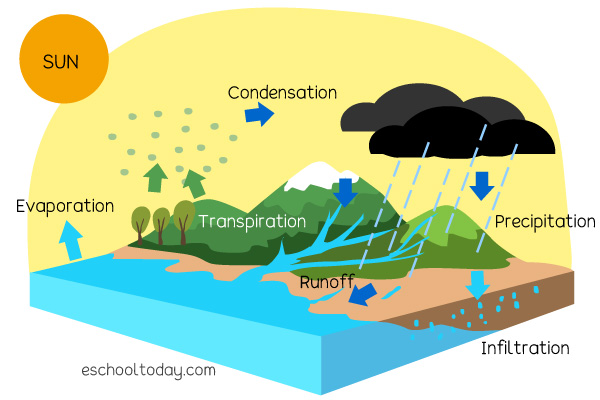- The Water Cycle
What is the Water Cycle?
The water cycle is simply the complete journey that water makes in its life, from one place to another and from one state to the other.
As the word cycle suggests, there is no starting point. That means that we can begin at any point on its journey and follow its path until it gets to where we started again.
Where does water come from, and where does all the rainwater end up? What about the melting snow? Why is it not filling up the lakes and lagoons and even the seas? How did the snow and rainwater find its way up in the sky in the first place? Today we will learn a bit more about what happens to water in all the various places on earth.
Let us see the cycle and stages in this diagram:

Stage 1: Evaporation and transpiration
Let us begin with the oceans and large water bodies. The large surface area absorbs the sun’s energy (heat), warming their surfaces. As the water heats up, it evaporates (turns from liquid to vapor). In addition to that, green plants (forests and all vegetation cover) also release moisture into the air in a process called transpiration. Rising air currents, resulting from unequal air pressure, lift the vapor high into the atmosphere.
Stage 2: Condensation
Up there, cooler temperatures cause the vapor to condense (water vapor turning back into liquid). Winds and air masses move the moisture around a bit, forming clouds. With time, they become heavier with water. That develops into rain-bearing clouds.
Stage 3: Precipitation
The water now comes down from the sky in the form of rain, snow, sleet, and hail.
Stage 4: Runoff and Infiltration
As the rainwater falls to the ground, they find their way on the ground surface into puddles, streams, and rivers. That occurs by the natural force of gravity, aided by slopes and gullies on sloping surfaces.
Besides runoff, water is absorbed into the soil in a process called infiltration. The absorbed water may even go deeper and replenish aquifers and other water pockets that exist naturally below the surface of the earth. That is known as percolation. Sometimes water in the ground moves up to the surfaces and can evaporate or runoff again.
So where does the runoff end up — in the seas and oceans and water bodies where we started. This picture is what is known as the water cycle. Now let us take the stages into a bit more detail, and learn what happens at each stage.
